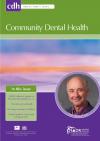Community Dental Health

- Cover Date:
- June 2016
- Print ISSN:
- 0265 539X
- Vol:
- 33
- Issue:
- 2
The mouth as a site of structural inequalities; the experience of Aboriginal Australians
Objective: To address the mouth as a site of structural inequalities looking through the lens of Aboriginal Australian experience. Research design: This is a critical review of published literature relevant to our objective. Criteria for selection included articles on: the social context of oral and general health inequalities for Aboriginal Australians; Aboriginal perceptions and meanings of the mouth and experiences of oral health care and the role of the current political-economic climate in promoting or compromising oral health for Aboriginal Australians. Results: Evidence suggests oral health is important for Aboriginal Australians yet constrained by challenges beyond their control as
individuals, including accessing dental services. Competing demands on limited budgets often led to oral health dropping off the radar unless there was an emergency. Conclusions: Structural (social, political and economic) factors often inhibited Aboriginal people making optimum health choices to prevent oral disease and access services for treatment. Factors included cost of services, limited education about oral health, intense advertising of sugary drinks and discrimination from service providers. Yet the literature indicates individuals, rather than structural factors, are held responsible and blamed for the poor state of their oral health. The current neoliberal climate focuses on individual responsibility for health and wellbeing often ignoring the social context. To avoid the mouth becoming an ongoing site for structural inequality, critically reviewing oral health policies and practices for whether they promote or compromise Aboriginal Australians’ oral health is a step towards accountability-related oral health outcomes.
Key words: inequalities, structural factors, oral health, health services, Indigenous
doi:10.1922/CDH_3717Durey03
- Article Price
- £15.00
- Institution Article Price
- £
- Page Start
- 161
- Page End
- 163
- Authors
- A. Durey, D. Bessarab, L. Slack-Smith
Articles from this issue
- Title
- Pg. Start
- Pg. End
- Child oral health in migrant families: A cross-sectional study of caries in 1-4 year old children from migrant backgrounds residing in Melbourne, Australia
- 100
- 106
- Feasibility, utility and impact of a national dental epidemiological survey of three-year-old children in England 2013
- 116
- 120
- A bi-level intervention to improve oral hygiene of older and disabled adults in low-income housing: results of a pilot study
- 127
- 132
- Caries and costs: an evaluation of a school-based fluoride varnish programme for adolescents in a Swedish region
- 138
- 144
- Examiner reliability in fluorosis scoring: a comparison of photographic and clinical methods
- 145
- 150
- Do ‘poor areas’ get the services they deserve? The role of dental services in structural inequalities in oral health
- 164
- 167
